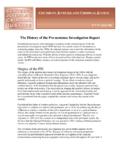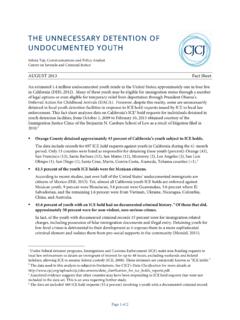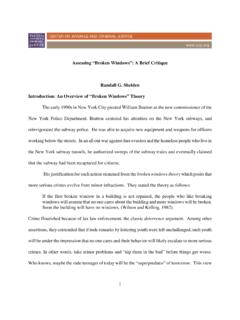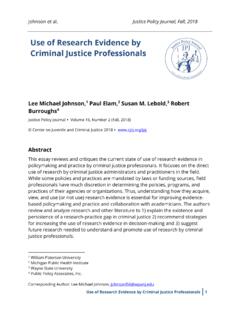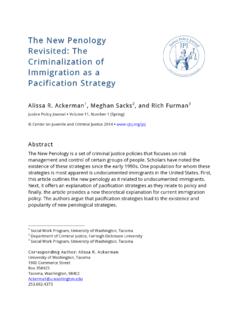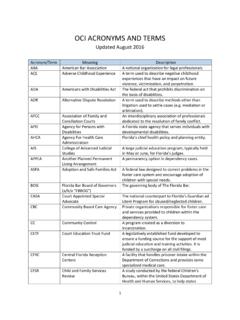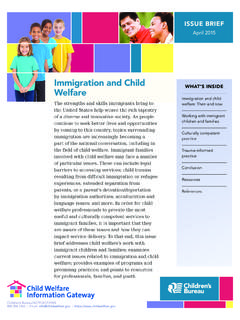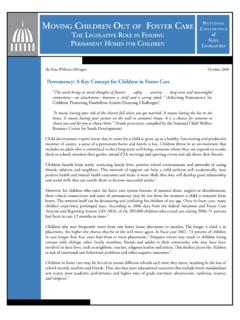Transcription of Parental Incarceration, Termination of Parental …
1 Parental incarceration , Termination of Parental Rights and adoption : A. Case Study of the Intersection Between the Child Welfare and Criminal Justice Systems Charlene Wear Simmons and Emily Danker-Feldman*. Volume 7 No. 2 Fall 2010. *Charlene Wear Simmons is an Adjunct Faculty Member at the University of Southern California and consults on policy and organizational development; previously she was Assistant Director of the California Research Bureau. Emily Danker-Feldman is a graduate student at Washington University in St. Louis pursuing a dual degree in law and social work. Abstract In this case study, we examine the intersection between the child welfare, judicial and correctional systems based on a review of all San Francisco child welfare adoption files from the years 2007 and 1997, when the federal adoption and Safe Families Act was enacted.
2 We found that less than a fifth of all parents, and only two percent with a history of incarceration , attended the dependency court hearings in which their children were detained, reunification requirements imposed, or Parental rights terminated. Most were not represented by attorneys. In all cases, mothers were the primary caretakers. Nearly 70 percent had criminal records and 54 percent had been incarcerated. Eighty seven percent had substance abuse issues and many also had mental health issues. They were disproportionately African American. The majority of their children were detained at birth due to illegal drug exposure. On average, mothers with more than one child in foster care had had children removed from their care.
3 Improved access to the courts; priority substance abuse and other programming; intensive, supervised case management services, and; accountability for court-ordered service results could prove cost effective and beneficial for these mothers, their children and society. About the Authors Charlene Wear Simmons, is an Adjunct Faculty Member at the University of Southern California and a consultant in policy and organizational development at the Davis Consultants Network. She recently retired as Acting Director of the California Research Bureau in the State Library. Her policy research publications are available at Please address all correspondence to 645 Oak Avenue, Davis, California 95616, or Emily Danker-Feldman is a graduate student at Washington University in St.
4 Louis pursuing a dual degree in law and social work. She has worked for a variety of feminist nonprofits and plans to continue advocating for women and children as a public interest lawyer. Please address all correspondence to 3404 Grass Hill Terrace, Falls Church, VA 22044 or We wish to acknowledge and express our appreciation to Superior Court of San Francisco Unified Family Court Presiding Judge Donna J. Hitchens and Court Manager Valerie McGrew;. Kimiko Burton, Office of San Francisco City Attorney; San Francisco Human Services Agency, Family and Children Services Division, Deputy Director Debby Jeter, Adoptions Supervisor Patricia Rudden, Protective Services Supervisor Helga Zimmerer, and CalWorks Supervisor Susan Arding; Program Officer Ellen Walker and the Zellerbach Family Foundation; Karen Shain, Co-Director, Carol Strickman, Staff Attorney, and Robin Rederford, Community Liaison, at Legal Services for Prisoners with Children; Leajay Harper, Center for Young Women s Development; Gretchen Newby, Friends Outside.
5 Nell Bernstein, San Francisco Children of Incarcerated Parents Partnership; Yali Lincroft, Consultant to the Annie E. Casey Foundation;. and, Joe Magruder at the Center for Social Sciences Research at the University of California, Berkeley. Any errors or omissions are ours alone. Parental incarceration , Termination of Parental Rights and adoption : A Case Study of the Intersection Between the Child Welfare and Criminal Justice Systems Introduction Parental Rights Are Conditional Parents exercise primary authority over their children and bear responsibility for their well-being and development. However, Parental rights are conditional upon protection of children s best interests.
6 States establish standards to ensure that children are educated, healthy and safe, and have their basic needs met. When parents become dysfunctional and endanger their children, the state has the responsibility to intervene. The scope, direction, and timing of this intervention are structured by federal and state laws, law enforcement and child welfare agency actions, and judicial decisions (Simmons 2003). When the state determines that a child s parents are either unable or unwilling to provide safe and appropriate care, the state assumes responsibility: The courts hold the legal responsibility for children who have been removed from their homes, serving in effect as parent and bearing the responsibility for their safety and well-being (Blue Ribbon Commission 2009).
7 In California, Child Welfare Service (CWS) agencies (also called Child Protection Services or CPS) assist the courts in providing neglected or abused children with appropriate care. These agencies are administered by county welfare departments with oversight from the California Department of Social Services. Juvenile Courts called Dependency Courts when hearing cases regarding dependent children have legal responsibility for children who have been removed from their homes due to abuse or neglect. These courts direct and monitor child placement and establish the conditions for family reunification. Child welfare workers are charged with creating a case plan for each child, assisting parents to secure court-ordered reunification services, such as substance abuse treatment, parenting classes or monitored visitation, evaluating the parents progress, and informing the courts.
8 Concurrently, child welfare workers create a permanency plan for the child which the court relies on in making its decisions. If a parent fails to meet the court s conditions after being offered appropriate services, or if the parent has already had another child removed from his or her care due to abuse or neglect, the court may terminate Parental rights. The child may be adopted, placed with relatives, or remain in long-term foster care. Parental incarceration and Foster Care The impact of the criminal justice system on prisoners families has grown along with the nation s federal and state correctional population, which increased from 130 inmates per every 100,000 residents in 1980, to 504 in 2008.
9 At the end of 2008, one in every 133 residents was in the custody of state or federal prisons or local jails (Sabol, West, Cooper 2010). Incarcerated women (62 percent) were more likely than men (51 percent) to report being a parent. Parental incarceration is a childhood risk that is concentrated among black children and children of low-education parents (Wildman 2009). The number of children with a mother in prison increased 131 percent between 1991 and midyear 2007. Over 40 percent of these mothers were single parents prior to their incarceration and most of their children went to live with relatives, friends, or were placed in foster care.
10 In contrast, 88 percent of children with incarcerated fathers continued to live with their mothers (Glaze and Maruschak 2008). Children whose parents are involved in the criminal justice system have an above average likelihood of entering foster care (Phillips et al. 2004). This is particularly true when a mother is incarcerated because many are single parents. Maternal incarceration can affect the length of time they [the children] spend in foster care, and the agencies plans to reunite families or identify other permanent homes for the children (Ehrensaft et al. 2003).. Studies by the Vera Institute of Justice and by the Chapin Hall Center for Children have compared criminal justice and foster care placement records in New York City and Cook County, Illinois, respectively, and found that reunification was less likely, and adoption more likely, for the children of incarcerated mothers (Ehrensaft et al.)
